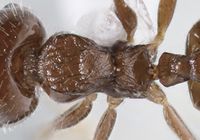Crematogaster simboloni
| Crematogaster simboloni | |
|---|---|

| |
| Scientific classification | |
| Kingdom: | Animalia |
| Phylum: | Arthropoda |
| Class: | Insecta |
| Order: | Hymenoptera |
| Family: | Formicidae |
| Subfamily: | Myrmicinae |
| Tribe: | Crematogastrini |
| Genus: | Crematogaster |
| Species: | C. simboloni |
| Binomial name | |
| Crematogaster simboloni Hosoishi & Ogata, 2014 | |
Nothing is known about the biology of Crematogaster simboloni.
Identification
Hosoishi and Ogata (2014) - A member of the Crematogaster fraxatrix group. This species is similar to Crematogaster chhangi and Crematogaster fraxatrix, but can be easily distinguished from these by the sculptured promesonotum in the worker caste.
Distribution
Indonesia: Krakatau.
Latitudinal Distribution Pattern
Latitudinal Range: 4.2024° to 4.2024°.
| North Temperate |
North Subtropical |
Tropical | South Subtropical |
South Temperate |
- Source: AntMaps
Distribution based on Regional Taxon Lists
Indo-Australian Region: Indonesia (type locality).
Distribution based on AntMaps
Distribution based on AntWeb specimens
Check data from AntWeb
Countries Occupied
| Number of countries occupied by this species based on AntWiki Regional Taxon Lists. In general, fewer countries occupied indicates a narrower range, while more countries indicates a more widespread species. |

|
Estimated Abundance
| Relative abundance based on number of AntMaps records per species (this species within the purple bar). Fewer records (to the left) indicates a less abundant/encountered species while more records (to the right) indicates more abundant/encountered species. |

|
Biology
Castes
Known only from the worker caste.
Nomenclature
The following information is derived from Barry Bolton's Online Catalogue of the Ants of the World.
- simboloni. Crematogaster simboloni Hosoishi & Ogata, 2014: 64, figs. 7, 8 (w.) INDONESIA (Krakatau Is).
- Type-material: holotype worker, 8 paratype workers.
- Type-locality: holotype Indonesia: Krakatau Is, Rakata I., 06°09’N, 105°28’E, 11.x.2000 (H. Simbolon); paratypes with same data.
- Type-depositories: MZBJ (holotype); BMNH, CASC, FRKL, KUEC, MCZC, MHNG, NHMB, TNHM (paratypes).
- Distribution: Indonesia (Krakatau).
Unless otherwise noted the text for the remainder of this section is reported from the publication that includes the original description.
Description
Worker
Measurements and indices. HW 0.59–0.72; HL 0.57–0.67; CI 102–108; SL 0.49–0.55; SI 75–85; EL 0.11–0.15; PW 0.34–0.39; WL 0.62–0.74; PSL 0.1–0.12; PtL 0.16–0.2; PtW 0.16–0.19; PtH 0.12–0.15; PpL 0.11–0.12; PpW 0.15–0.17; PtHI 72–82; PtWI 95–113; PpWI 125–155; WI 83–100 (fourteen workers measured).
Workers monomorphic. Posterior corners of head rounded. Anterior clypeal margin slightly concave in the median portion. Compound eyes projecting slightly beyond lateral margins of head in full face view. Scape reaching posterior corner of head. Antennal club 3-segmented. Pronotal dorsum with distinct ridges laterally. Mesonotal dorsum with lateral ridges. Mesonotum slightly higher than pronotum in lateral view. Metanotal groove straight in dorsal view, deep and forming a concave region between mesonotum and propodeum. Propodeal spines long, directed upward and straight. Propodeal spiracles oval, flattened dorso-ventrally, located on the lateral sides of propodeum, or the postero-lateral corners; the horizontal diameter slightly larger than the vertical diameter. Petiole broader in the middle portion. Subpetiolar process undeveloped. Postpetiole weakly bilobed with feeble median sulcus. Petiole as wide as postpetiole in dorsal view. Sparsely hirsute with erect setae. Scape with abundant erect to suberect setae. Dorsal face of head with suberect setae. Clypeus with suberect setae; one pair of longer setae medially on anteriormost portion. Anterior clypeal margin with one single setae and one pair of longer setae, mixed with some shorter ones on the side. Mesosoma with short and sparse erect setae. Fourth abdominal tergite with few erect to suberect setae. Dorsal surface of head generally smooth and shining, but feeble rugulae between frontal carinae; longitudinal rugulae surrounding antennal sockets and on gena. Clypeus striated with longitudinal rugulae. Pronotum striated with longitudinal rugulae with the sculptured space; the longitudinal rugulae separated from anterior mesonotal margin. Mesonotum sculptured. Lateral surface of pronotum smooth and shining. Mesopleuron sculptured, but the central portion relatively smooth. Propodeal dorsum sculptured anteriorly. Lateral surface of propodeum weakly sculptured and striated with feeble rugulae. Body color brown.
Type Material
Holotype worker: pinned. Original label: INDONESIA, Rakata Island, Krakatau Islands, 06°09'S, 105°28'E, 11.x.2000, H. Simbolon leg., deposited at Bogor Zoological Museum. Eight paratype workers: pinned, same data as holotype; deposited at The Natural History Museum, California Academy of Sciences, Forest Research Institute Malaysia, Kepong, Kyushu University Collection, Museum of Comparative Zoology, Musee d'Histoire Naturelle Genève, Naturhistorisches Museum, Basel, Natural History Museum of the National Science Museum.
Etymology
This species is dedicated to Dr. Herwint Simbolon, Research Centre for Biology, Lembaga Ilmu Pengetahuan Indonesia (The Indonesian Institute of Sciences), who collected the type material.
